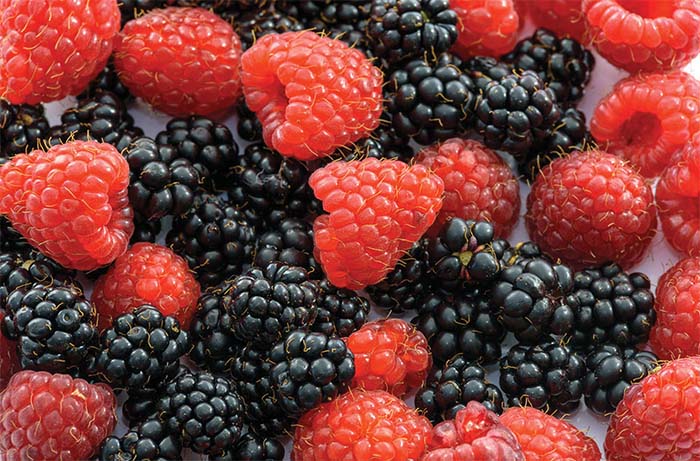Bulletin #2066, Growing Raspberries and Blackberries
Bulletin #2066, Growing Raspberries and Blackberries (PDF)
Developed by David T. Handley, Vegetable and Small Fruit Specialist, University of Maine Cooperative Extension
For information about UMaine Extension programs and resources, visit extension.umaine.edu.
Find more of our publications and books at extension.umaine.edu/publications/.
Table of Contents:
- Selecting a Planting Site
- Preparing the Soil
- The Raspberry Plant
- VIDEO: How to Grow Raspberries (YouTube)
- Suggested Varieties
- VIDEO: Different Varieties of Raspberries, Part 1 (YouTube)
- VIDEO: Different Varieties of Raspberries, Part 2 (YouTube)
- Planting and Management Systems
- VIDEO: How to Plant Raspberries (YouTube)
- Care and Fertilization
- Pruning
- VIDEO: How Do I Prune Raspberries? (YouTube)
- Harvesting Raspberries
- Insect and Disease Management
Raspberries and blackberries can be a most enjoyable crop for the conscientious gardener. Red raspberries are readily adaptable throughout New England, but black and purple raspberries and blackberries lack the hardiness to be grown north of well-sheltered sites in southern Maine and New Hampshire.
Selecting a Planting Site
To get the most out of your raspberry planting, choose your site carefully. Raspberries prefer full sunlight and grow best in well-drained, sandy loam soils rich in organic matter. Avoid low areas that remain wet late into the spring, but select a site with access to a water supply. Irrigation is important for good plant growth during dry periods and can improve fruit size and yield. Do not plant raspberries where tomatoes, potatoes, peppers, or eggplant have been grown within the past four years, because these crops carry a root rot called Verticillium that can also attack raspberries. Destroy all wild raspberry and blackberry plants within a distance of 600 feet of your planting site if possible, to reduce the possibility that virus diseases might be spread to your planting. New raspberry plants will not compete well with grass or other weeds. It is best to till up the entire site you intend to plant rather than digging holes or tilling narrow strips into an existing sod. Grass can then be seeded between the rows after the raspberries are established. If you plan to plant into an existing sod, be sure that the ground is tilled and weed free for at least two feet on all sides of the raspberry plants to prevent competition.
Preparing the Soil
Getting the soil ready for raspberries may take up to two years, depending on its condition. Test the soil to determine its pH and fertility levels. Raspberries prefer a soil pH of 5.6 to 6.2; acid soils may require applications of ground limestone to increase the pH. Soil testing information is available from your county Cooperative Extension office. You can improve the level of organic matter in the soil and discourage perennial weeds by sowing a cover crop such as buckwheat, rye, millet, or oats, and plowing it into the soil before it goes to seed. There should be time enough for two sowings in a single season. Applications of barnyard manure or compost and repeated tilling for a full season can be substituted for cover cropping. Be aware that animal manures may contain weed seeds that can become a problem in your planting later. In the spring of the planting year, spread 25 pounds of 10-10-10 garden fertilizer per 1,000 square feet of the planting site. Organic fertilizer sources such as compost, manures, sul-po-mag, and rock phosphate may be used in place of synthetic fertilizers. Apply enough of these materials to deliver two pounds each of nitrogen, phosphorus (P2O5) and potassium (K2O) per 1,000 square feet. Cultivate the soil several days before planting to incorporate the fertilizer and break up any clumps or clods.
The Raspberry Plant
The crowns and roots of raspberry plants are perennial, but individual canes live for two years. Each spring, the plants produce canes (suckers) from buds on the crown and on underground lateral stems. These canes, called primocanes grow vegetatively during the first season, overwinter, and produce fruit during the summer of the second year on short branches called laterals. These second-year canes, called floricanes die shortly after fruiting, while new primocanes emerge to provide a crop for the following year. Everbearing-type raspberries bear a small crop on the tips of the primocanes canes in the fall, followed by a typical summer crop on the lower portion of the same canes the second year.
It’s easy to tell first-year canes from second-year canes. First-year canes have green stems, while second-year canes have a thin, brown bark covering them.
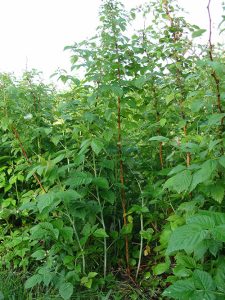
Although a wide selection of raspberry varieties is available, only a few will do well under the short growing seasons and severe winters of northern New England. Select only those that are rated very hardy with early or mid-season ripening.
In general, red raspberries are the hardiest type, followed by purple raspberries, black raspberries, and blackberries. Temperatures below 5°F can injure or kill blackberry and most purple and black raspberry canes, so these should only be planted in southern parts of Maine and New Hampshire, on protected sites.
Order your plants from a reputable nursery or garden dealer. Specify disease-free, virus-indexed stock. Raspberries from mail-order nurseries are sold as dormant, bare-root, one-year-old canes, but retail garden centers often sell actively growing potted plants.
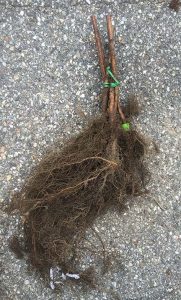
Suggested Varieties
Summer-bearing Red Raspberries
Boyne: Early ripening. Large crops of medium-sized, dark red berries with good flavor. Short, spiny canes. Very hardy.
Killarney: Ripens mid-season. Medium-sized, bright red fruit with good flavor. Short, spiny canes with many fine thorns. Very hardy.
Newburgh: Ripens mid-season. Large, round, bright red fruit with fair flavor. Good for freezing. Vigorous plants with very few thorns. Hardy.
Nova: Ripens mid-season. Medium-sized fruit, bright red, firm. Resistant to most cane diseases.
Latham: Mid-to-late ripening. Medium-large fruit, prone to crumbling, with fair flavor. Plants are vigorous with few thorns. Very hardy.
Prelude: Very early ripening, good quality fruit on vigorous canes. Hardy.
Encore: Late ripening. Large fruit of good quality, vigorous plants. Hardy.
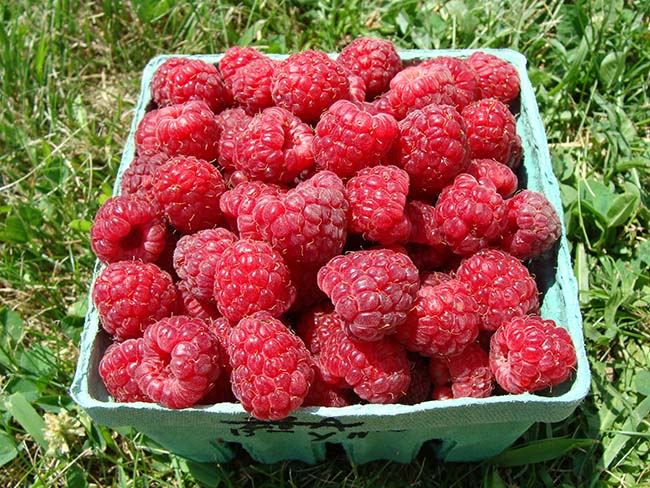
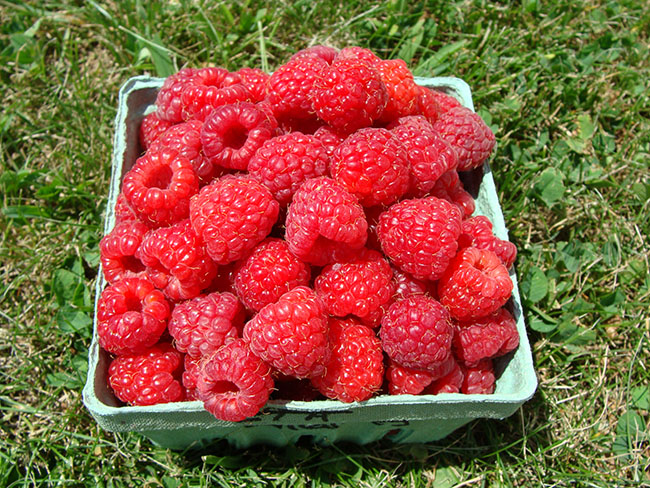
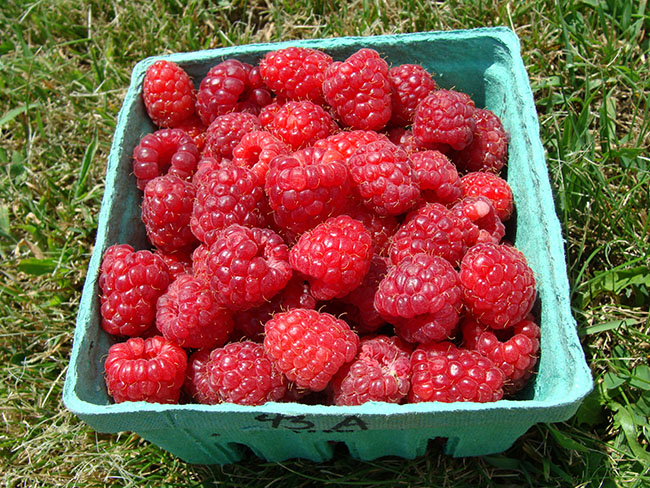
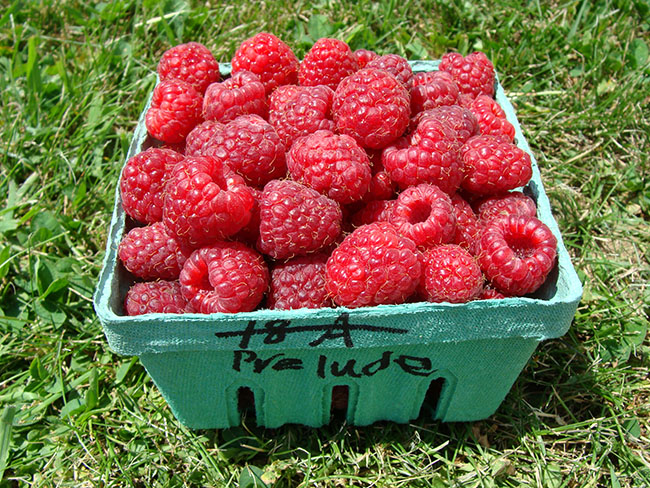
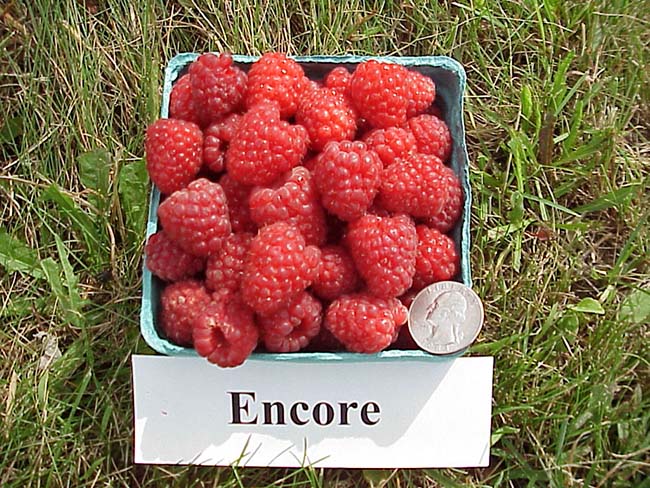
Everbearing Red Raspberries
August Red: Earliest ripening of everbearing types. Soft, medium-sized fruit with fair flavor. Short, spiny canes.
Polana: Early ripening fall crop, medium-sized, good quality fruit. Vigorous plants, but canes need support.
Polka: Ripens about a week later than Polana; may be too late for more northern sites. Medium-large fruit, very good quality. Vigorous, upright canes.
Joan J: Ripens about a week later than Polana; may be too late for more northern sites. Medium-large fruit, very good quality. Moderately vigorous, very few thorns.
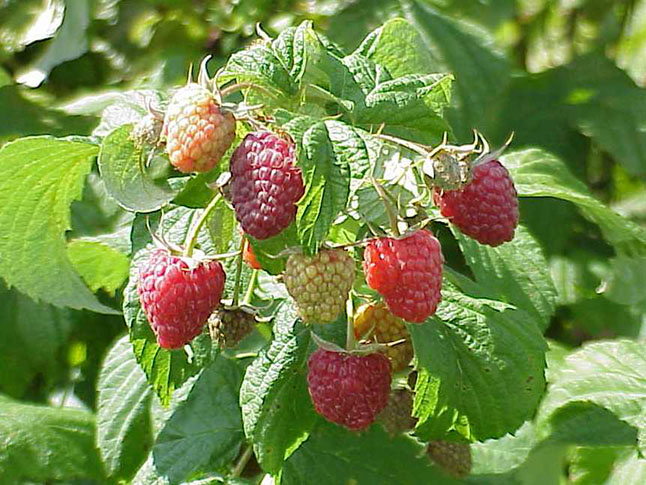
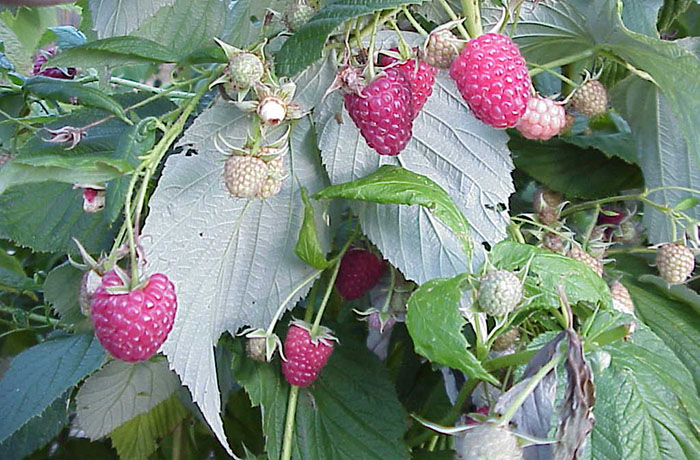
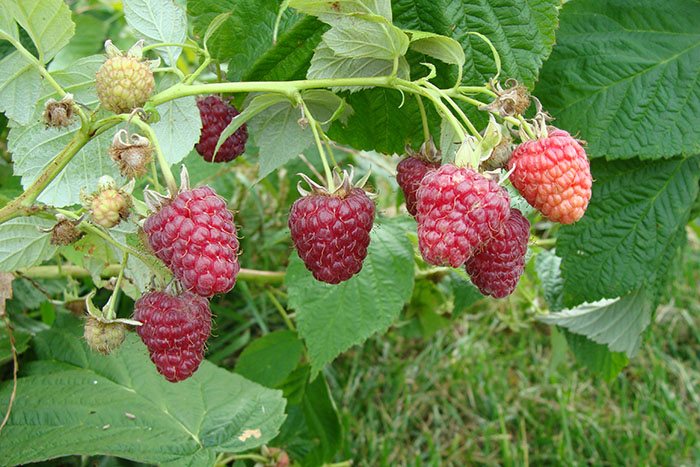
Black Raspberries
Jewel: Mid-season ripening. Firm, glossy fruit with good flavor. Vigorous, erect plants.
Early Sweet: Early ripening, firm, glossy with good flavor. Vigorous plants.
Niwot: An everbearing type that will have a summer crop on two-year canes and a fall crop on new canes. Fruit are large and firm with good quality. Fall crop may not ripen in more northern sites.
Blackberries
Darrow: Large, glossy fruit with good flavor. Vigorous, erect plants with large thorns, but susceptible to virus.
Illini: Large fruit, vigorous plants with large thorns.
Purple Raspberries
Royalty: Late ripening. High-yielding, large, round, reddish-purple fruit that is soft, with good flavor. Large, vigorous canes with thorns. Susceptible to root rot. May not be adequately hard for more northern sites.
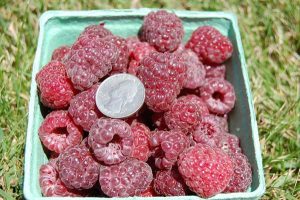
Planting and Management Systems
Plant raspberries early in the spring after the danger of severe frost is past (late April to mid-May). Do not allow plant roots to dry out before or during planting. Bare root plants should be set at the same depth or slightly deeper than they were in the nursery. Spread the roots out at the bottom of the planting hole or trench. Firm the soil around the roots and water the plants. Potted plants should be removed from the pot and planted deep enough to cover the top of the root ball by about an inch. It is best to loosen the roots from the root ball, especially if they have become pot-bound, to encourage new growth to anchor the plants in the soil.
Red raspberry plants are typically grown in a hedgerow. Crowns should be planted about 2 feet apart in rows that are 8 to 12 feet apart. Choose the wider spacing if you’ll be using large equipment, such as tractors, in the planting. Spacing rows too close together will make access very difficult once the canes reach their full height. The plants will soon send up suckers from the roots and crowns to form a hedge, which should be maintained at 12 to 18 inches wide at the base.
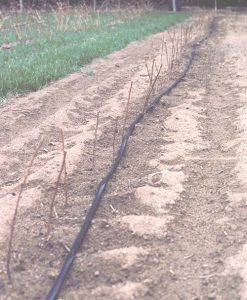
Purple and black raspberries and blackberries mostly produce suckers from the base of the crown and will not fill out a hedgerow as red raspberries do. For this reason, they are frequently grown in the hill system to get the most production out of individual plants. For this system, set plants 4 feet apart in rows 8 to 12 feet apart.
After planting, mulch, such as wood chips or bark can be applied around the plants to a depth of 4 to 6 inches to prevent weed growth and help retain soil moisture.
All raspberries should be grown with some sort of trellis. This will improve fruit quality, make harvesting easier, and reduce disease problems. Trellises also make pruning simpler by encouraging new cane growth in the middle of the row, rather than just along the outside edges. For plants grown in a hedgerow, the “T” or “V” trellis systems are recommended.
(Click on image to enlarge.)
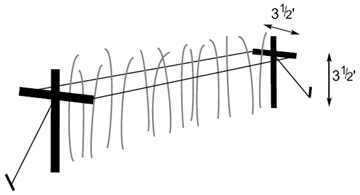
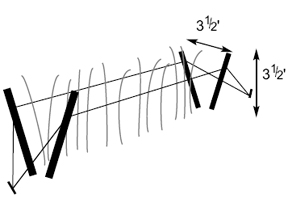
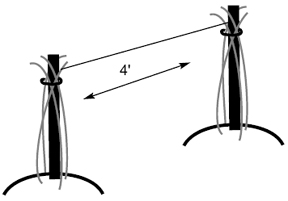
Care and Fertilization
Keep the planting completely free from weeds with shallow cultivation and hand pulling as necessary. Make sure the plants receive one to two inches of water a week for best growth. Mulch can be used to reduce weed problems within the plant rows and also to help retain soil moisture and add valuable organic matter. Spread wood chips, bark, pine needles, or rotted leaf mulch over the plant rows, and maintain it at a depth of three to four inches.
Starting the second year of the planting, a cover crop may be planted between the rows. Sow an annual cover crop, such as spring oats, just after harvest. The oats will help harden off the raspberry plants for winter by using up excess water and nutrients in the soil, and will also reduce weed growth. Oats will be killed by low winter temperatures, and the dead sod cover will reduce soil erosion in the spring.
A permanent cover crop may also be sown following harvest the second year. Sow a noncompetitive grass cover, such as a dwarf perennial rye-fescue mix, between the plant rows. Take care to prevent grass from spreading to within a foot of the raspberry plants, or it will compete with the raspberries for water and nutrients. Permanent sod covers allow easy access in the raspberry planting, prevent soil erosion and weed growth, and can be easily maintained by regular mowing.
Raspberries should be fertilized each year in the early spring (mid-April). Apply 20 pounds of 10-10-10 (or organic equivalents) per 1,000 square feet of the planting. Increase the rate to 25 pounds if a heavy mulch is being used.
It is best to split the application, applying half of the recommended amount in mid-May and the second half four to six weeks later.
Pruning
Pruning is a vital part of maintaining a healthy raspberry planting. This practice greatly inhibits the spread of raspberry diseases and improves fruit quality and yield. During the summer months, regularly remove all new canes that emerge outside the desired plant row width of 12 to 18 inches. This improves light penetration and air circulation for the canes in the middle row that will fruit next year. Also, remove any canes that show obvious signs of insect or disease injury. In the late winter or early spring, before the buds break, remove all of the old canes that fruited the previous year. These have gray, peeling bark and branches (they are dead and won’t fruit again). Again, remove canes that have emerged outside of the desired 12- to 18-inch row width. Maintaining this narrow row width will assure adequate light penetration and air circulation to promote healthy cane growth and reduce disease problems. Only the most vigorous canes, those with the greatest height and basal diameter, should be left in the row. Continue thinning until only four to five canes per foot of row length remain. These remaining canes should be attached to the trellis wires with twine. Finally, remove all of the plant waste from the field. Plant waste can harbor diseases and insects that may attack healthy canes.
Everbearing or fall-bearing red raspberries bear a late-season crop on first-year canes. If they are pruned in the same manner as the summer-bearing types, they will bear two crops per season; one in the summer on the second-year canes, and one in the fall on the first-year canes.
Everbearing raspberries can also be managed to produce only the fall crop. Simply mow all the canes down early each spring. During the summer, cut down any new canes that develop outside the 12- to 18-inch row width and thin the remaining canes to about six inches apart, leaving the sturdiest. This technique greatly reduces pruning labor but also eliminates the summer crop. Unfortunately, most everbearing cultivars, such as Heritage, produce the fall crop too late in the season to escape damage from frost in most of northern New England.
Blackberries should have the growing tips of the new canes pinched off when they reach four feet. This encourages the canes to form side branches, or laterals, which will bear fruit in the following year. Remove all canes that fruited following the harvest. In the early spring, thin the remaining canes, leaving only five to seven of the sturdiest per hill. Cut the side branches back to 12 buds (usually about 12 inches in length) and tie the canes to the wire or post for support.
Remove all plant waste from the field after pruning and destroy it, preferably by burning or composting. Leaving dead canes in the planting will encourage the spread of diseases.
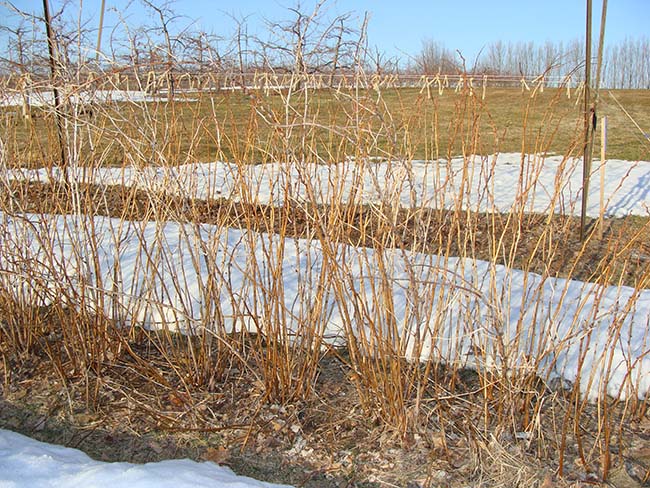
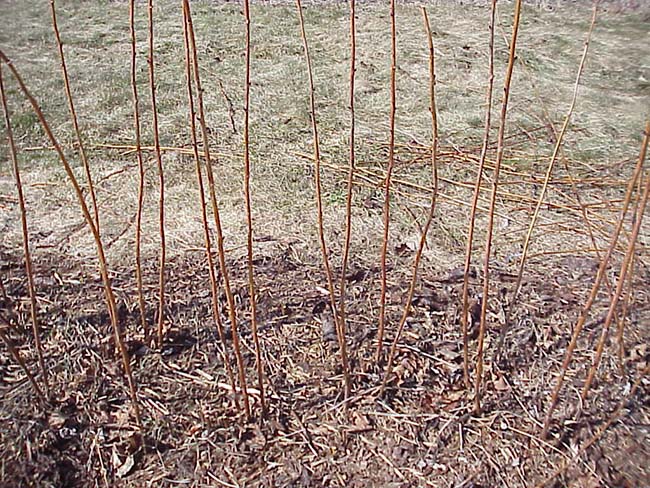
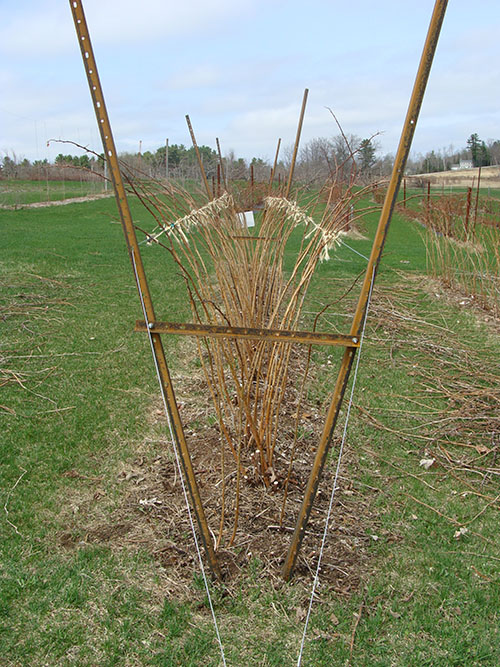
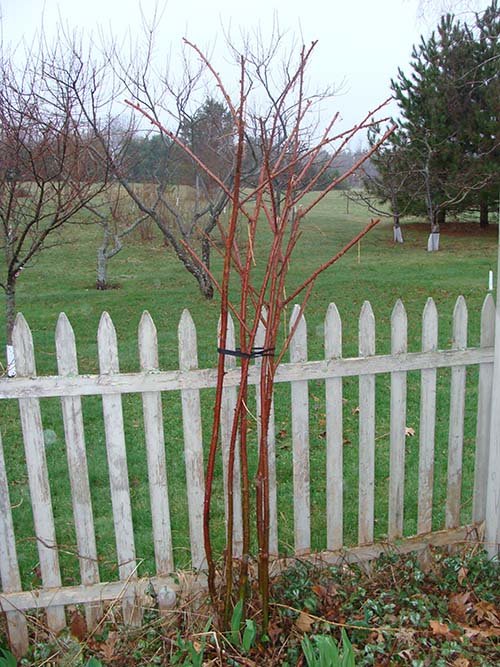
Harvesting Raspberries
Raspberries are ready to pick when they easily separate from the receptacle or core. Blackberries do not separate from the core, so ripeness should be judged by color and taste.
All bramble fruit is extremely perishable and should be harvested frequently. To maintain fresh quality, place the fruit in shallow containers, no more than three berries deep, and cool the fruit to 33°F as quickly as possible. Fruit properly harvested and held at this temperature can maintain fresh quality for three to seven days. If the fruit is to be made into jam or jelly, process it immediately, or freeze it until ready to use.
Insect and Disease Management
A well-kept raspberry planting can provide fruit for 10 to 20 years, but weeds, viruses, fungi, and several types of insects can greatly reduce yield and may destroy the planting if they are not controlled. Many problems can be prevented by proper planning and care.
Select only raspberry cultivars that are very hardy and plants that are certified virus-free. If possible, destroy all wild brambles within 600 feet of the planting. Encourage good air circulation by having at least 8 feet between your plant rows and keeping the hedges to a 12- to 18-inch width. Prune your plants regularly to promote healthy new growth and reduce the spread of diseases. Keep the planting weed-free to discourage insect pests and prevent competition for water and nutrients.
For specific pest identification and management techniques, contact your University of Maine Cooperative Extension County Office.
Information in this publication is provided purely for educational purposes. No responsibility is assumed for any problems associated with the use of products or services mentioned. No endorsement of products or companies is intended, nor is criticism of unnamed products or companies implied.
© 1990, 2006, 2023
Call 800.287.0274 (in Maine), or 207.581.3188, for information on publications and program offerings from University of Maine Cooperative Extension, or visit extension.umaine.edu.
In complying with the letter and spirit of applicable laws and pursuing its own goals of diversity, the University of Maine System does not discriminate on the grounds of race, color, religion, sex, sexual orientation, transgender status, gender, gender identity or expression, ethnicity, national origin, citizenship status, familial status, ancestry, age, disability physical or mental, genetic information, or veterans or military status in employment, education, and all other programs and activities. The University provides reasonable accommodations to qualified individuals with disabilities upon request. The following person has been designated to handle inquiries regarding non-discrimination policies: Director of Equal Opportunity, 101 Boudreau Hall, University of Maine, Orono, ME 04469-5754, 207.581.1226, TTY 711 (Maine Relay System).


